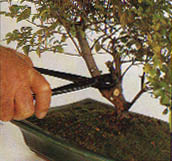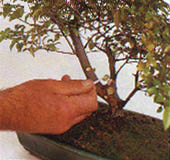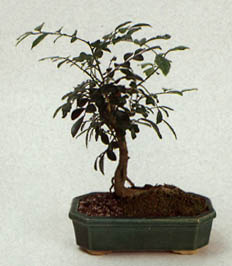[ How to water ]
[ How to make a cut ]
[ How to prune ]
[ How to jin a branch ]
[ Wiring a tree ]
[ Root pruning and repotting ]
[ Planting in rock ]
How to water a bonsai
More Bonsai die from lack of water than for any other reason.Use a fine rosette on the watering can, and hold it far enough
above the cantainer to reduce the speed of flow to a steady stream.
Repeat two or three times, to ensure that water penetrates as
far as the rootball. Any excess will drain through the holes
at the bottom of the container.
If the soil surface is very dry, immerse the whole container
so that water is absorbed through the drainage holes into the rootball.
Then, water from above. Always try to avoid watering in brilliant
sunshine which may dry the surface of the soil before the water
has time to reach all parts of the container,
and which can result in burnt foliage.
How to make a cut

After branch pruning, a dead stump often has to be removed. Use curved branch cutters, available in a variety of sizes, if possible. |

You can, if you wish, apply a flexible healing compound to the cut to spur healing, but the wound will heal without this treatment. |

A concave cut heals flat, the cambium forming a callous. A flat cut, on the other hand, would heal with an unsightly bump. |
How to prune

On evergreens, wait until the shoot has hardened off, and cut where a new shoot is growing. This makes the cut difficult to see. |

This tree obviously needs pruning. Using long-handled scissors, cut to a shoot that is growing in the direction you want. |

After pruning, the tree's basic shape is again visible. This is the method to follow for deciduous trees. |
How to jin a branch
The top of this Pinus parviflora (Japanese white pine)
has died because training wire was left on too long.
Instead of removing it, it can be cut and bleached to form a jin.
Cut off any wood you don't want with branch cutters.
Remove the bark and cambium layer from the remaining branch
with a sharp, sterilized knife.
The jin gives an immediate look of age to the tree.
Wiring a tree
Start by securing the wire into the rootball, then warp the wireround the trunk. Try to keep the wire at a 45º angel to the trunk.
When wiring branches, wire two together,
so that one exerts pressure on the other.
The thinner the branch, the finer the wire to use.
The tree loses its shrubby look once the wire is in place.
Be sure to remove wires before they start to
“bite” into the trunk or branches.
Root pruning and repotting

1. The mass of roots, many of which have reached the edge of the container, are ample proof that this tree needed root pruning, and then repotting.
|

2. Remove the soil from around the roots, and tease out the roots with a chopstick or other blunt stick or with a special bonsai root rake, available from bonsai nurseries.
|
Planting in rock

| 1. Position the roots of your chosen tree so that they will fall into natural crevices of the rock. Use a little “muck” to hold them in place. Muck acts as a clay-like, sticky fixative, making a bed for the roots and establishing a medium through which they can absorb all the water and nutrients they need. Combine milled and unmilled sphagnum moss, sterilized topsoil and a small quantity of unmixed perlite in equal parts. To this mix add enough water to make it hold together in a ball. Knead it and try to press as much air from the mix as possible. |

2. If the tree's roots are not long enough to reach the container initially, wrap the rootball and rock tightly with twine to prevent roots sprouting out sideways. |

3. Wrap the rootball in plastic and bury it in a deep container filled with sand. This will encourage long, branching roots to grow. Then, plant the tree in the rock. |
Top
Top
Main page
Very beautiful Bonsai images
This information from the book 'Bonsai'
by Susan M. Bachenheimer Resnick
ISBN: 1-85501-683-4



